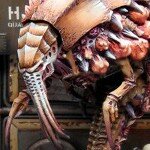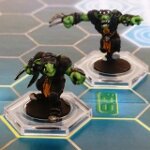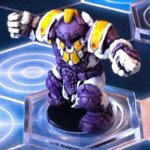 Forge Fathers! The Dwarfs of DreadBall.
Forge Fathers! The Dwarfs of DreadBall.
Like the Goblin & Orx Marauders, Forge Fathers are often considered one of the weaker teams from DreadBall Season 1. I’ve seen a fair few tournaments around the UK Midlands that give Marauders and Forge Fathers a few extra points to put them on a more equal footing.
Forge Fathers are a challenging team to play in DreadBall, and one of the few teams that rely heavily on passing the ball, which makes mastering Forge Fathers on the pitch very rewarding.
#1 – Forge Fathers Game-Play Basics
Forge Fathers are fragile and slow, but deliver powerful hits and handle the ball with skill.
The biggest challenge to playing Forge Fathers is that they are – contrary to Dwarven stereotypes – one of the most fragile DreadBall teams around.
Forge Father Strikers Dodge on 5+ (Speed) with an Armour save of 5+, making them the most delicate DreadBall players of Season 1 and 2! Forge Father Jacks and Guards share the vulnerability of the 5+ dodge if they cannot deliver one of their feared 3+ (Strength) slambacks.
The Forge Fathers’ other weakness is their low movement of 4. Rolling Speed-tests of 5+ also means that Forge Fathers should think twice before doing things like Dashing (moving extra hexes) or Evading (moving within reach of opposing players), all of which hurts their mobility.
The Forge Fathers advantages are their high Strength. Their Jacks can hit as hard as most Guards from other teams. Forge Father Guards are rightly feared. Skill 4+ makes Forge Fathers competent at handling the ball, play a solid passing game and score reliably.
#2 – The Forge Father Team
The Forge Father team starts with 3 Guards, 3 Jacks and 2 Strikers, giving them players from all three player-roles in DreadBall. Unlike the Goblin Jacks and Orx Guards of the Marauder team, all Forge Father players share the same stat-line (except for their armour save).
| Move | Strength | Speed | Skill | Armour | |
| Guard | 4 | 3+ | 5+ | 4+ | 4+ |
| Jack | 4 | 3+ | 5+ | 4+ | 4+ |
| Striker | 4 | 3+ | 5+ | 4+ | 5+ |
Forge Fathers are unique in the Season 1 in that their Guards all start with a player skill: Steady.
Steady prevents players from being knocked down as the result of a Slam. If a Forge Father Guard isn’t send straight to the injury bin (or trips himself), he’ll remain upright and fighting playing. Doubly useful for Forge Fathers who struggle more than most to stand up (rolling for Speed on 5+).
#3 – Forge Fathers in One-Off Games
In one-off games and tournament (with, usually, very limited access to skills), Forge Fathers usually rely on the hard slams by their Jacks and Guards to keep their opponent on the defensive.
A common approach to scoring for Forge Fathers is to keep vulnerable Strikers in their own half, picking up the ball and passing it forward to the more robust Jacks, who do the actual scoring.
Even so, the Forge Fathers’ limits to play long distances usually means they go for a combination of low scores and attrition (“bashing ‘eads”) to win these games, rather than the 3/4-pointers and Landslide victory that quicker, more nimble DreadBall teams favour.
#4 – Forge Fathers in Leagues
Forge Fathers love league-play. The right set of skills can have a huge impact on their players.
Similar to Marauders, Guards tend to gain experience faster than the scoring players. Fortunately, the right set of skills can turn Forge Father Guards into truly frightening players on the pitch and Forge Father Jacks into tough “receivers” that are very hard for the opponent to shift.
Guards and Jacks usually try getting 360° Vision (or Alert for Jacks, both skills from Season 2) as quickly as possible so they can defend themselves with their 3+ Strength in all directions.
Other useful advancements are…
Jacks
- Skill 3+ – As Forge Fathers rely heavily on passing the ball, Skill 3+ is a great improvement that helps the Jack in both catching the ball (with a free action if possible) and scoring.
- Safe Pair of Hands – As above, it helps with catching the ball.
Guards
- Can’t Feel a Thing! – The classic. Being harder to hurt, what’s not to like!
- Keeper – For the 3+ save, more than anything. Combined with 360° Vision and Steady (and Can’t Feel a Thing!), a Forge Father Keeper is a rock that will not move. Ever!
For Strikers, it is tempting to try making them more durable with experience.
It does take a lot of advancements though to make Forge Fathers Strikers moderately robust, and even than only through the “Extra Coaching Table” (Season 1 rulebook, p. 58), which is expensive to use. They also tend to gain experience only very slowly (and die too easily).
I’d recommend to simply gun for Skill 3+ instead, making them better at passing the ball.
#5 - Thoughts?
Long story short, Forge Fathers are best at hitting hard and passing the ball. It does take some mental adjustment to see your “Dwarfs” as the fragile players on the pitch that need protecting, at least if you’re attracted to Space Dwarfs by their tough and dogged image.
Pulling off a good (as in well-planned) passing game with Forge Fathers, which brings together all three player roles – Guards bashing, Strikers throwing and Jacks catching – makes playing DreadBall a tactically deep and rewarding game however, that few other teams can match.
Though Forge Fathers are a Season 1 team, I tend to look at them as one of the “pro-teams” for experienced DreadBall players.
- Have you played Forge Fathers in DreadBall? Or against them?
- What strategies work for you when you play Forge Fathers?
- Are their alternatives to the “passing-game-approach” outlined above?
Let me know what you think and leave a comment!
Z.
A Note on the Forge Father DreadBall Miniatures
Mantic Games’ DreadBall Forge Father miniatures are pretty cool, arguably among the best Dwarf-sculpts out there. That said, the visual differences between Guards, Jacks and Strikers are relatively minor and easily obscured by a less-than-perfect paint-job.
I strongly recommend a paint-scheme that makes the different player-roles easily visible, by differently coloured helmets or bases or similar solutions.
Especially in tournaments, when the clock is ticking, I have not yet played against a Forge Father player that didn’t get a Jack and a Guard mixed up in the heat of things, no matter how often they insist before the game that they’ve got it down.
Make it easy for your opponent and yourself to tell them apart!























Recent Comments